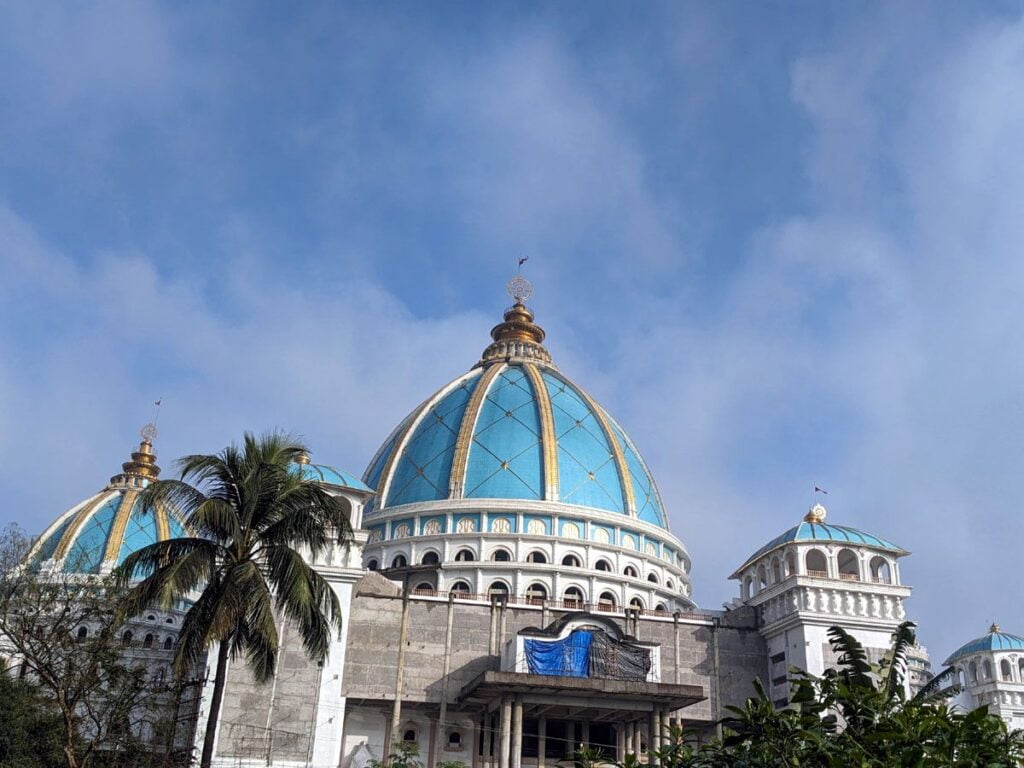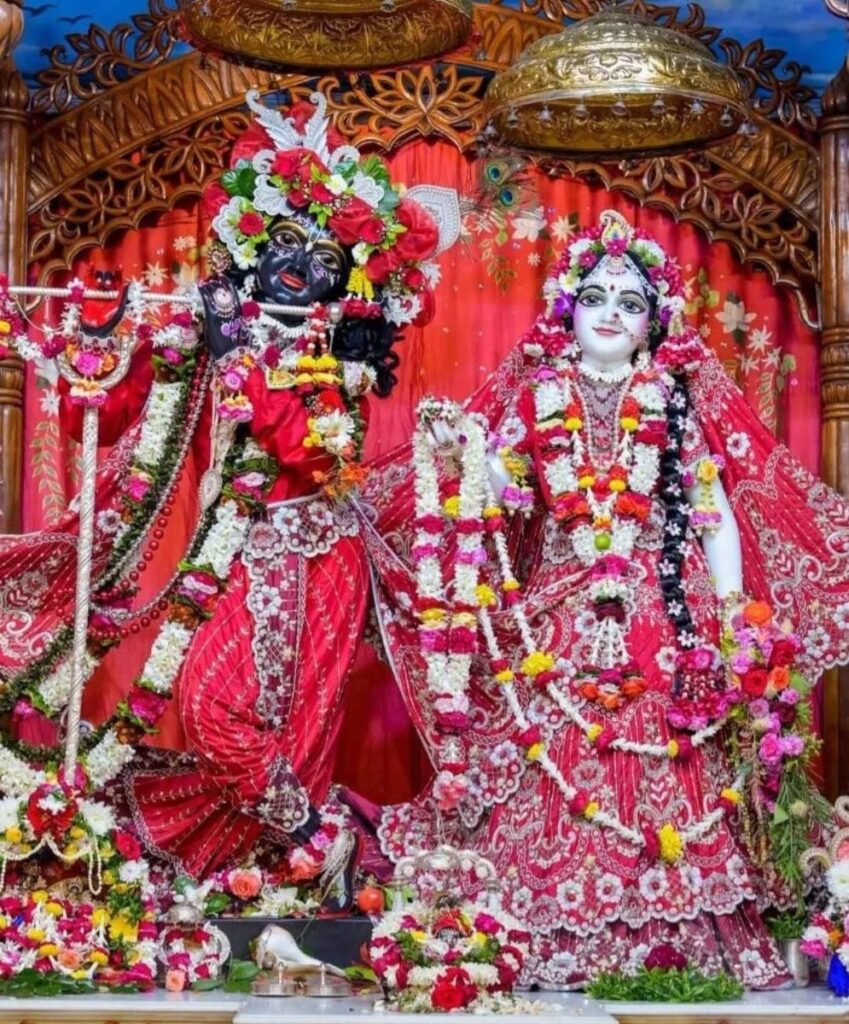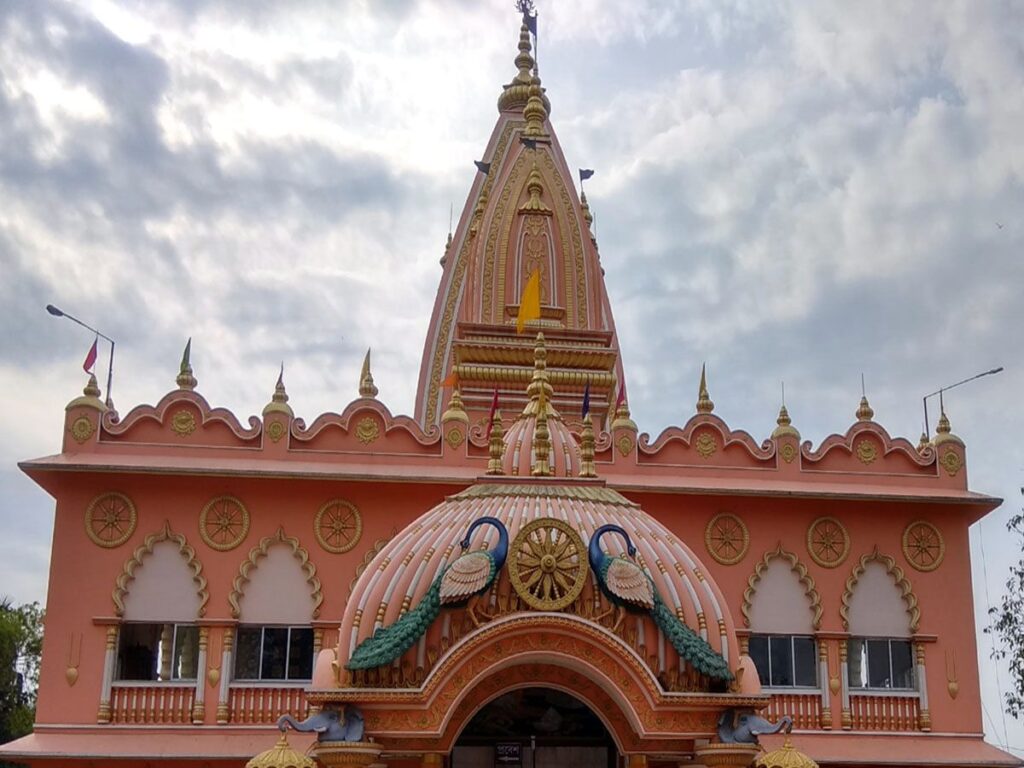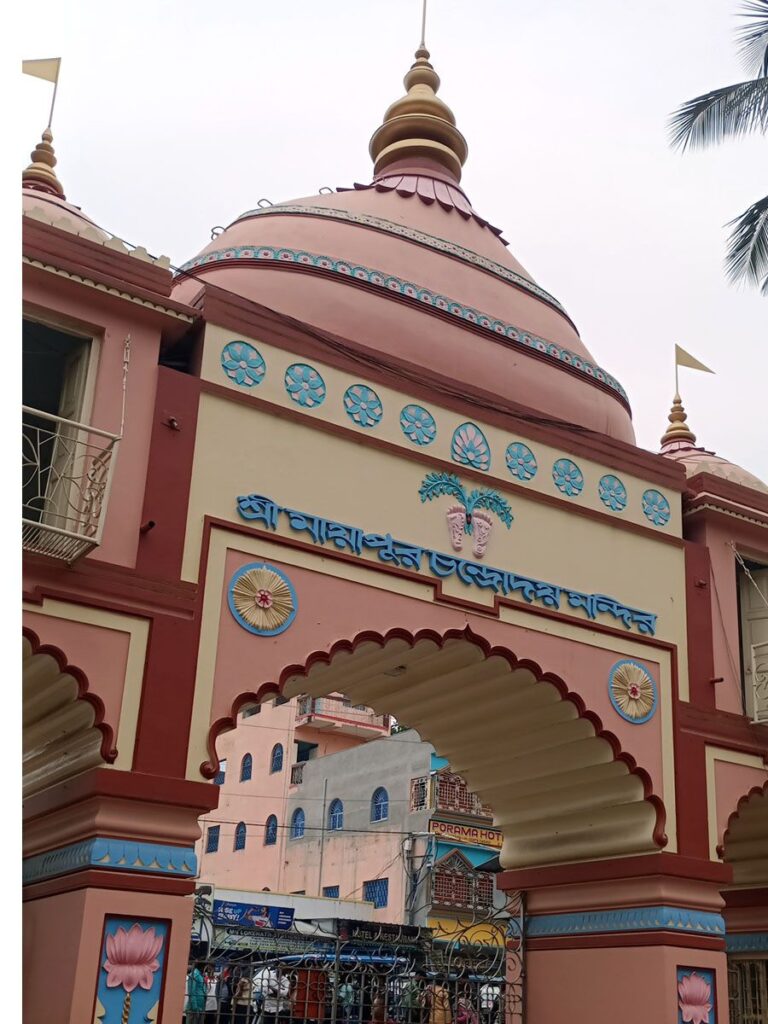Mayapur Temple of the Vedic Planetarium
The Temple of the Vedic Planetarium is a massive and ambitious project under construction in Mayapur, West Bengal, India. It’s being built by the International Society for Krishna Consciousness (ISKCON) and aims to make the vast Vedic culture and philosophy accessible to everyone.

Upon completion, it’s expected to be the largest religious monument in the world, surpassing the Taj Mahal and St. Paul’s Cathedral. Its grand scale reflects the significance of Vedic knowledge and its potential to impact humanity.
Contents
- 1 Architecture of the Temple of the Vedic Planetarium:
- 2 Planetary model Temple of the Vedic Planetarium:
- 3 Museum and exhibits:
- 4 Places to visit near Temple of the Vedic Planetarium:
- 5 FAQ:
- 5.0.1 Q: What is the Temple of the Vedic Planetarium?
- 5.0.2 Q: What makes the temple unique?
- 5.0.3 Q: What is the temple’s purpose?
- 5.0.4 Q: What is the temple’s current status?
- 5.0.5 Q: How can I visit the temple?
- 5.0.6 Q: Where can I learn more about the project?
- 5.0.7 Q: What is the total cost of Vedic Planetarium?
- 5.0.8 Q: Who is the founder of Vedic Planetarium?
- 5.0.9 Q: In which state is the Vedic Planetarium Temple being built?
- 5.0.10 Q: Is ISKCON Mayapur completed?
- 6 How to reach Temple of the Vedic Planetarium:
- 7 Google Maps:
Architecture of the Temple of the Vedic Planetarium:
A Blend of East and West:
- Vedic Inspiration: The temple design draws heavily from ancient Vedic architectural principles, particularly Vastu Shastra. Geometric shapes and proportions hold spiritual significance, promoting harmony and positive energy flow.
- Global Fusion: Materials and techniques showcase a unique blend of East and West. White Makrana marble from India contrasts with blue Bolivian marble to create a stunning visual palette. Construction methods seamlessly integrate traditional craftsmanship with modern engineering.
Key Features:
- Grand Scale: Upon completion, the temple will be the largest ISKCON temple globally, boasting a massive 60-meter diameter base and a towering central dome exceeding 100 meters.
- Rotating Planetarium: Inside, a 24-meter tall and 30-meter wide rotating model depicts the planetary systems described in Vedic scriptures, offering a unique educational and devotional experience.
- Intricate Details: Exquisite hand-carved sculptures, murals, and paintings adorn the temple walls, narrating stories from Hindu mythology and Vedic texts.
Some Unique Aspects:
- 2.5-acre Pujari Floor: Offering ample space for large gatherings and ceremonies.
- 20-meter Vedic Chandeliers: Adorning the shrines with intricate crystal and gold detailing.
- Focus on Spiritual Experience: The architecture itself acts as a catalyst for devotion, connecting visitors with the divine through its grandeur and symbolic elements.
Read More>> Hasanamba Temple: Stone Sleeps & Spirit Awakes

Planetary model Temple of the Vedic Planetarium:
Here’s a glimpse into the planetary model of the Temple of the Vedic Planetarium:
Structure: The Cosmic Chandelier will be suspended from the apex of the temple’s main dome, reaching a staggering height of 108 feet. It will be composed of multiple tiers, representing different cosmic layers and planetary systems.
Planets: Each tier will showcase various planets, moons, and celestial bodies, crafted with intricate detail and illuminated to reflect their individual characteristics. Visitors will be able to observe the relative sizes, positions, and movements of these celestial objects.
Movement: The model will be designed to rotate slowly, simulating the celestial dance described in Vedic texts. This dynamic presentation will add a mesmerizing layer to the visual experience.
Layers: The Cosmic Chandelier will depict not only the physical planets but also higher spiritual realms like Vaikunthaloka and Goloka Dhama, the abode of Lord Krishna. This multi-dimensional representation will offer a glimpse into the vastness and complexity of the Vedic cosmology.
Educational and spiritual value: Beyond its visual grandeur, the Cosmic Chandelier aims to educate visitors about Vedic knowledge and inspire spiritual contemplation. Each planet and realm will be accompanied by informative displays and presentations, explaining their significance in Vedic literature and mythology.
Here are some additional details about the planetary model:
The model will be based on the descriptions found in the Srimad Bhagavatam, Brahma Samhita, and other Vedic texts.
The TOVP Cosmology Research Group is currently developing the model, consulting with scientists, artists, and Vedic scholars.
The model is expected to be completed by 2024, along with the opening of the temple.
Read More>> 2500 Years Dwarkadhish Temple: Where Miracles Still Happen

Museum and exhibits:
Here’s what you can expect at the “Vedic Science Museum” within the Temple complex:
Centralpiece:
- Giant Rotating Model of the Universe: This massive, chandelier-like structure depicts the planetary systems based on the Srimad-Bhagavatam, offering a unique perspective on Vedic cosmology.
Exhibits:
- Dioramas, Charts, and Videos: These multimedia elements provide detailed information about the various regions of the cosmic creation, from the lower planets to the spiritual realms.
- Displays of Vedic Art and Culture: Paintings, sculptures, and other artifacts offer insights into the aesthetics and traditions associated with Vedic knowledge.
Overall Experience:
- Interactive learning: Touchscreens, audio guides, and multimedia presentations make the exhibits engaging and accessible for visitors of all ages and backgrounds.
- Spiritual perspective: The exhibits connect scientific concepts with spiritual realities, providing a deeper understanding of the universe and our place within it.
Deities: The temple will be dedicated to the Pancha-Tattva deities, namely Radha Madhava, Nrisimhadeva, and Chaitanya Mahaprabhu. Each deity will have their own grand altars and halls, adorned with beautiful murtis and decorations.
Significance:
- Spiritual center: The Temple of the Vedic Planetarium is envisioned as a global spiritual center, attracting devotees and seekers from all corners of the world. It aims to bridge the gap between traditional Hinduism and modern society, offering a platform for spiritual exploration and understanding.
- Cultural impact: The temple’s construction and operation will significantly impact Mayapur and the surrounding region. It’s expected to boost tourism, generate employment opportunities, and contribute to the overall development of the area.
Current status:
- Construction progress: The temple is still under construction, with several sections like the Nrsimhadeva wing already completed. The opening date is expected to be sometime in 2024.
- How to support: Devotees and well-wishers can contribute to the temple’s construction through donations and volunteer work. The official website of the Temple of the Vedic Planetarium (https://tovp.org/) provides information on various ways to get involved.
Visiting the temple:
- Location: The Temple of the Vedic Planetarium is located in Mayapur, West Bengal, approximately 130 km from Kolkata.
- Accessibility: Mayapur is well-connected by road, rail, and air. Regular trains and buses operate from Kolkata and other major cities.
- Accommodation: Mayapur offers various accommodation options, ranging from budget-friendly dharamshalas to comfortable hotels and guest houses.
The Temple of the Vedic Planetarium is a truly remarkable project that promises to be a landmark not only for Hinduism but for the world as a whole. Its completion will be a testament to the enduring power of Vedic knowledge and its potential to inspire and guide humanity.
Read More>> Enchanted Pashupatinath Temple

Places to visit near Temple of the Vedic Planetarium:
- Mayapur Chandrodaya Mandir: This is the temple where the Temple of the Vedic Planetarium is located. It’s a magnificent structure and one of the main attractions in Mayapur.
- ISKCON Mayapur Campus: The ISKCON campus itself is quite extensive, with beautiful gardens and other temples. Take the time to explore the entire campus.
- Sri Chaitanya Math: This is a matha (monastic organization) dedicated to Sri Chaitanya Mahaprabhu, a key figure in the Gaudiya Vaishnavism tradition. It is situated in Mayapur and is an important pilgrimage site.
- Ganga River Cruise: Mayapur is situated on the banks of the Ganges River, and you might find boat rides or cruises available for a peaceful experience on the holy river.
- Rajapur Jagannath Temple: Located about 10 kilometers from Mayapur, this temple is dedicated to Lord Jagannath and is another significant pilgrimage site.
- Nabadwip: This town is considered the birthplace of Chaitanya Mahaprabhu and is about 20 kilometers from Mayapur. It has historical and religious significance.
- Ballal Dhipi: It is an archaeological site with remnants of an ancient Buddhist monastery, located near Mayapur.
- Chand Kazi’s Samadhi: This is the samadhi (tomb) of Chand Kazi, who was a magistrate during the time of Chaitanya Mahaprabhu. It’s a historical site associated with the pastimes of Chaitanya Mahaprabhu.
Read More>> Subramanya Swamy Temple Thiruparankunram

FAQ:
Q: What is the Temple of the Vedic Planetarium?
A: The Temple of the Vedic Planetarium (TOVP) is a monumental Hindu temple complex under construction in Mayapur, West Bengal, India. It’s dedicated to the Pancha-Tattva deities, Radha Madhava, Nrisimhadeva, and Chaitanya Mahaprabhu. Upon completion, it’s poised to be the largest religious monument in the world.
Q: What makes the temple unique?
A: The temple boasts several unique features, including:
- Size and grandeur:
- Largest dome on a religious monument: Measuring 177 feet in diameter, it surpasses the Taj Mahal and St. Peter’s Basilica.
- Among the tallest Hindu temples: Reaching 347 feet, it offers breathtaking views of the surrounding Ganges River and Mayapur countryside.
- Cosmic chandelier: A magnificent chandelier showcasing the Vedic cosmology will hang from the dome’s center.
- Interactive exhibits: Educational and immersive exhibits will delve into Vedic knowledge, culture, and philosophy.
- World’s largest gold-plated chakra: Measuring 23 feet in diameter, this stunning chakra symbolizes spiritual progress.
Q: What is the temple’s purpose?
A: The TOVP aims to:
- Disseminate Vedic wisdom: Make the vast and timeless Vedic tradition accessible to everyone, regardless of background or belief.
- Inspire spiritual growth: Provide a sacred space for prayer, meditation, and devotional practices.
- Promote cultural understanding: Foster appreciation for Hindu culture and its contributions to the world.
Q: What is the temple’s current status?
A: Construction is ongoing, with several sections already completed. As of December 2023, the temple floor and two floors of the planetarium exhibit are expected to open by July 2024.
Q: How can I visit the temple?
A: While the main temple hasn’t opened yet, visitors are welcome to explore the completed sections, including the Nrsimhadeva Hall, a breathtaking tribute to Lord Nrsimhadeva. You can find more information and updates on the official TOVP.
Q: Where can I learn more about the project?
A: The TOVP website offers a wealth of information, including videos, photos, and news updates. You can also follow them on social media for the latest developments.
Q: What is the total cost of Vedic Planetarium?
The total cost of the Vedic Planetarium (TOVP) in Mayapur, India, is estimated to be over $1 billion USD. This ambitious project, undertaken by the International Society for Krishna Consciousness (ISKCON), is set to become the largest religious monument in the world upon completion.
Q: Who is the founder of Vedic Planetarium?
The Founder of the Vedic Planetarium (TOVP) in Mayapur, India, cannot be attributed to a single individual in the traditional sense. Instead, it’s more accurate to speak of the concept originating from two key figures:
1. A.C. Bhaktivedanta Swami Prabhupada: The founder of the International Society for Krishna Consciousness (ISKCON), also known as the Hare Krishna movement, laid the vision and inspiration for the TOVP. In his discourses and writings, he expressed his desire for a grand temple in Mayapur, showcasing the Vedic perspective of the universe and serving as a center for spiritual learning.
2. The International Society for Krishna Consciousness (ISKCON): As a collective effort, ISKCON took Prabhupada’s vision and transformed it into the detailed plans and construction of the TOVP. Numerous devotees and dedicated individuals within ISKCON, including designers, architects, engineers, and fundraising teams, have contributed significantly to bringing the project to life.
Q: In which state is the Vedic Planetarium Temple being built?
The Temple of the Vedic Planetarium (TOVP) is being built in the state of West Bengal, India. Specifically, it is located in the town of Mayapur, in the Nadia district, approximately 130 kilometers north of Kolkata, the state capital. Mayapur holds a significant place in Krishna Consciousness tradition as the birthplace of Chaitanya Mahaprabhu, a revered saint.
Q: Is ISKCON Mayapur completed?
It’s important to clarify what you mean by “ISKCON Mayapur” as it can refer to different aspects of the Hare Krishna movement’s presence in Mayapur, India:
1. Mayapur Chandrodaya Mandir: If you’re referring to the central temple complex with the grand dome, officially called the Mayapur Chandrodaya Mandir, also known as the Temple of the Vedic Planetarium (TOVP), then it’s still under construction. While significant progress has been made, with several wings nearing completion, the opening date is currently estimated for sometime in 2024.
2. ISKCON Community in Mayapur: If you’re asking about the overall ISKCON community and infrastructure in Mayapur, then it’s much more developed. It includes existing temples, ashrams, guesthouses, schools, farms, and other facilities catering to devotees and visitors. This established community forms the base for the ongoing construction of the TOVP.
How to reach Temple of the Vedic Planetarium:
By Air: The nearest major airport is Netaji Subhas Chandra Bose International Airport (CCU) in Kolkata. From the airport, you can hire a taxi or take public transportation to reach Mayapur. The distance from the airport to Mayapur is approximately 130 kilometers.
By Train: Mayapur does not have its own railway station. The nearest major railway station is in Krishnanagar City Junction (approx. 21 km from Mayapur). You can take a train to Krishnanagar and then hire a taxi or take a bus to reach Mayapur.
By Road: Mayapur is well-connected by road. You can hire a taxi or take a bus from Kolkata to reach Mayapur. The journey by road may take a few hours, depending on traffic and road conditions.
